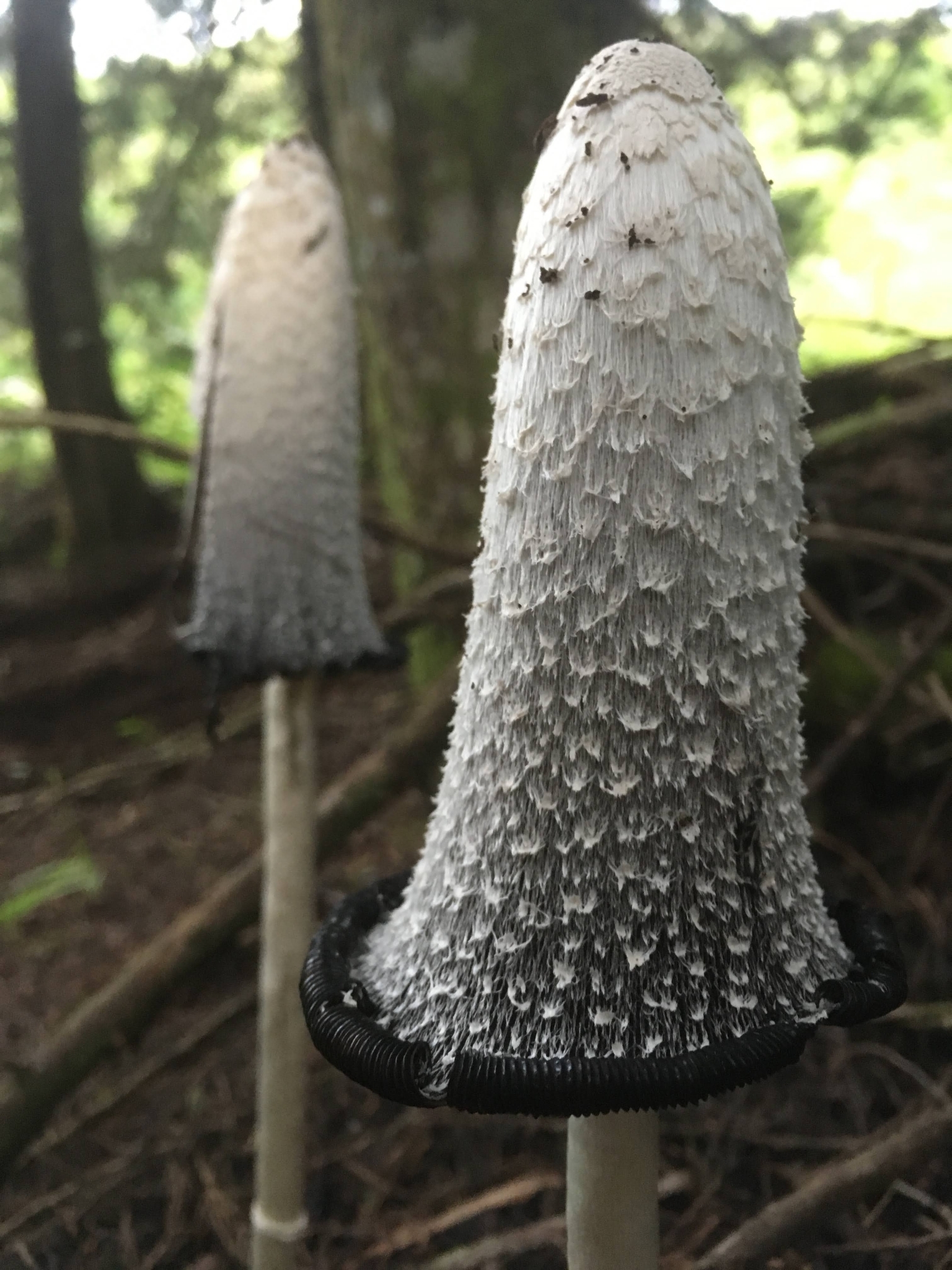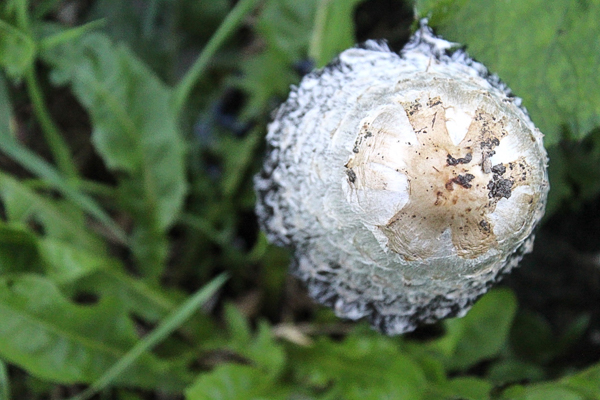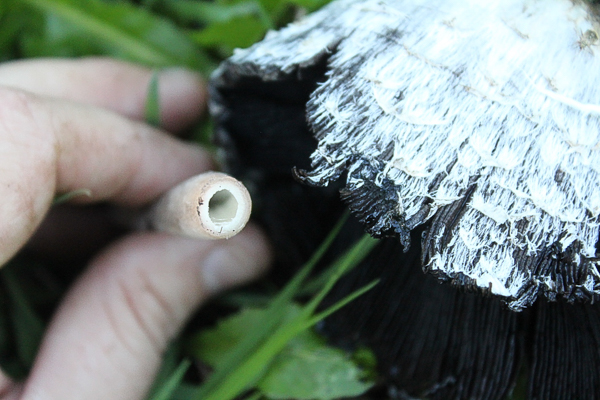Affiliate disclosure: This post may contain affiliate links. Please see our Privacy Policy.
Shaggy Mane mushrooms (Coprinus comatus) are incredibly easy to identify, and a great choice for beginning foragers. They’re one of the “foolproof four” or the four most easily identified mushrooms, along with chicken of the woods, giant puffballs, and morels. They are also known as lawyer’s wigs because they look a bit like the old-school wigs used in historical courtrooms.
They have only one common look alike, which is also edible, reducing the worry of harvesting the wrong species.

Natural History Of Shaggy Mane Mushrooms
Shaggy Manes (Coprinus comatus) are some of the most widely distributed mushrooms on the planet. They’re known in most parts of North America and Europe and occur in most other parts of the world, too. From deserts to jungles, cities, and even regions near the Arctic Circle, it’s a species you can count on finding no matter where you’re located.
Conveniently for those seeking them out, they’re also particularly fond of human-influenced landscapes. They occur in pastures, parks, trail sides, and other areas disturbed by human activities. Roadsides, both paved and dirt, tend to be prevalent habitats for Shaggy Mane. Shaggy Manes is also famous for growing directly through asphalt, and in some anecdotes, they can even lift concrete slabs on sidewalks! Since mushrooms are known to bioaccumulate toxins, it is urged to use caution when picking any mushroom growing from potentially contaminated areas.

Ecologically, they are considered decomposers and obtain their carbon from organic materials in the soil. They are also known to be nematophagous, a cool way to say they hunt and eat nematodes. They hunt them in various ways, including making lassos with their hyphae. If you want to geek out, there’s a cool video about this phenomenon here.
One of the exciting features of Shaggy Mane mushrooms is that they “self-destruct.” Once mature, they begin producing enzymes that break down their own tissues from the inside out. This process, known as deliquescence, typically starts at the bottom of the cap, which begins turning into a gooey ink and curling upwards. This process is believed to help the mushroom with spore dispersal. Shaggy Manes and their close relatives are sometimes collectively known as “Inky Caps” due to this phenomenon.

In some Asian cultures, there is a tradition of using this ink for calligraphy and art. Rumor also has it that during WW2, the Germans utilized Shaggy Mane ink for official statements and letters. If spores were present in the ink under a microscope. You can make your own Shaggy Mane ink by placing a fresh mushroom in a bag or jar. Within 12-24 hours, it should be a liquid ink!
This self-destruct feature makes Shaggy Manes very ephemeral. They often appear and vanish within a single day. This means if you find a patch of Shaggy Mane, it’s best to harvest them right then and there.
This being said, you should only harvest Shaggy Mane under a couple of conditions. Firstly, only harvest them if you can get them to your kitchen rather quickly—within 3-4 hours—because any longer, you might end up with an inky mess in your mushroom bag/basket. Refrigeration can slow this process down, but no more than 12 hours.

To go along with that, it’s only recommended to harvest young and pristine mushrooms. In most cases, older, mature specimens won’t make it to your kitchen in time. On top of this, older specimens are mostly water and don’t tend to be as delicious.
Lastly, it’s good to consider that there are many different forms of Shaggy Manes, depending on your location. It’s a group of mushrooms that still requires a lot of research, and it’s unclear whether these forms are distinct species, sub-species, or simply varieties. Many people consider Coprinus comatus a species complex because of this. Notice that some of the pictures included have a “brown” shaggy tone while others are more grey in color.

Shaggy Mane Mushroom Identification
With their distinctive scaly conical cap, shaggy mushrooms are easy to identify.
Look for a whitish cone mushroom cap with upturned scales. The scales, or the shaggy parts of the shaggy mane, are often grey, tan, or reddish-brown, which makes them easy to see against the light-colored background of the mushroom cap.
The flesh of the mushroom cap is fragile and easily broken. Be very careful when handling shaggy manes because they’ll fall apart easily, even when fresh.
Once they’ve aged even slightly, they disintegrate even more easily.

The gills start out as white, but they quickly become black and inky.
These mushrooms degrade rather quickly, and that’s how they get their other common name, inky cap. The ink itself is used to color dishes and in recipes for its distinctive natural food dye.
The spores themselves are a deep black color.

Stems of shaggy manes are fibrous and hollow.
They start out wider at the bottom and taper slightly towards the top where they attach under the mushroom cap.
When you break off the stem at the ground level, you should see a hollow tube leading up under the mushroom cap.

When you touch a shaggy mane past prime, or the gills of just about any specimen, they’ll color your hand with a black ink-like substance.
This mushroom ink was once used as an ink substitute, and they’re sometimes called inky cap mushrooms, though that usually refers to their look alike.
More on that later.

If you look closely under an older mushroom, the inky substance may have already started shedding. There will be a pool of “black mushroom goo” accumulating on the grass or soil under the mushroom.
This one’s still good, if you cook it immediately.
Even a few hours from now, it’ll be too far gone to be edible.

Where to Find Shaggy Mane Mushrooms
Shaggy manes grow in late summer and fall, appearing directly out of the ground. You can find them in lawns, wood chip piles, rocky soil or any patch of compacted and abused land.
They’re a great mushroom for urban foragers since they tend to prefer compacted or degraded soils. They’ll often appear in compacted soils along the edges of driveways right after a rain.

Shaggy manes often appear singly, growing alone out of a patch of grass. Sometimes they’ll appear in tightly packed groups, making them easy spot.
If you do happen to find a large quantity at once, take care to only harvest as many as you can use that day.
The mushrooms won’t keep, and they need to be used within hours of harvest.
Shaggy Mane Look-Alikes
Shaggy manes do have a couple of look alike mushrooms, but keeping these key identification characteristics in mind will help you positively ID the real thing:
Lookalike Checklist
- Shaggy Manes are large mushrooms of at least 4-6 inches in size
- Lookalikes typically grow from manure or woody debris, while Shaggy Manes grow directly from the soil.
- Shaggy Manes have a characteristic “shaggy” texture on their cap, while lookalikes have a smooth texture or scales.
- Shaggy Manes has an elongated cap that is not spherical and never flattens out.
There are quite a few mushrooms that have similar features to Shaggy Manes, although they are difficult to mistake. These often go by the blanket term “Inky Cap,” which for some folks also includes Shaggy Manes. For the context of this text, the term Inky Cap will only be used in reference to the lookalikes of Shaggy Mane.
Common Ink Cap (Coprinus atramentarius)
Despite their physical resemblance, Inky Caps are actually only distantly related to Shaggy Manes. Inky Caps include mushrooms in the genera Coprinellus and Coprinopsis, which together have more than a hundred species.
Despite there being many Inky Caps, most of them are too small to confuse anyone looking for Shaggy Mane. These small, inky caps typically grow directly from manure or rotting woody material. Real Shaggy Mane mushrooms are generally large and robust mushrooms of at least 4-6” in size and grow directly from the soil. Some Shaggy Manes can be over a foot in size!

The common ink cap (Coprinus atramentarius) or inky cap looks quite a bit like a shaggy mane, at a glance, but much smaller.
Both mushrooms produce a black ink-like substance, and both have an elongated bullet-like shape when fresh, but the inky cap lacks the “shaggy” portions on the cap that help to positively identify shaggy manes.

Shaggy manes usually grow singly, while inky caps are commonly found in groups.
Inky cap is also edible, but it can cause adverse reactions in combination with alcohol. Drinking after eating inky cap mushrooms results in nausea, vomiting, and heart palpitations and gets worse if more alcohol is consumed.
This issue only happens in combination with alcohol, so avoid consuming alcohol, and you won’t have to worry.
Keep in mind, that the issue can arise even drinking alcohol up to 48 hours after consuming inky caps.

Other Inky Cap Mushrooms
Other potential candidates have much smoother caps that lack the characteristic “shaggy” texture (as is the case with Coprinopsis atramentaria and Coprinellus micaceus).
Some species of ink caps also have white patches of loose tissue on the cap surface, which is again much different from the “shaggy” texture of the Shaggy Mane.

Shaggy Parasol Mushrooms
Lastly, one of the other potential lookalikes for Shaggy Mane is the Shaggy Parasols. These grow in very similar environments and have a shaggy texture on the cap. When these are young, and the cap is still closed, they can look a bit like a Shaggy Mane to the untrained eye. The biggest difference is that Shaggy Parasols have a much more spherical rounded cap, whereas Shaggy Manes have a long “oval” cap.
Once matured, there is no way to mistake them since the Shaggy Parasol has a cap that flattens out, while the Shaggy Mane begins to form its characteristic ink.

How to Cook Shaggy Manes
Collect shaggy manes when they’re young, before they start to degrade. Once they’re picked, shaggy manes will become inky and degrade within hours.
That’s one reason you won’t find them in fancy restaurants. Putting them in the refrigerator will slow the process and buy you a few more hours, but they still need to be prepared before the day is out.
They’re commonly used in risotto, a creamy rice dish, where they dissolve and create a dramatic black colored dish.
How do shaggy manes taste?
When fresh, shaggy manes have a very subtle earthy flavor.
They’re good for pairing with simple dishes, like pasta or chicken. Don’t bother combining them with anything strongly flavored because they’ll just be lost.
Once shaggy manes begin to age, their flavor changes.
Forager Chef describes the transition, “Something interesting happens when the mushroom begins its transformation into a puddle of black goo though, the flavor changes slightly, becoming intense and aromatic, something you could describe as being more ‘mushroomy.'”

Preserving Shaggy Manes
Generally speaking, it’s often not recommended to harvest more than a meal’s worth of Shaggy Manes since they have a very, very short shelf life. It’s difficult to dehydrate Shaggy Mane as they’ll often turn into ink within your dehydrator! That’s not fun to clean up afterward.
This being said, Shaggy Manes can occur in large numbers, so preserving them can be attractive. The simplest and best way to preserve Shaggy Manes is by cooking and freezing them. Heating them will destroy their digestive enzymes, and freezing them will preserve them until you’re ready to eat them!
Shaggy Mane Recipes
Once you’ve harvested shaggy mane mushrooms from a good clean location (away from runoff or areas with contamination potential), here are a few ways to cook them:
- Fried Parmesan Crusted Shaggy Manes from Forager Chef
- Cream of Shaggy Mane Soup from The Myco Boutique
- Shaggy Mane Risotto from The Baked Alaska Project
Beginning Mushroom Foraging Guides
Want to learn more about mushroom identification? Check out these other mushroom foraging guides:
- 13+ Edible Wild Mushrooms for Beginners
- Foraging Reishi Mushrooms
- Foraging Chanterelle Mushrooms
- Foraging Lion’s Mane Mushrooms





Can you eat them raw?
It isn’t recommended to eat mushrooms raw. You should always cook them thoroughly.
Hi, the Encyclopedia of Toxicology says Coprinus comatus does not contain coprine.
https://www.sciencedirect.com/science/article/pii/B9780123864543007545
The inky caps that do contain it are Coprinopsis atramentaria, C. insignis, C. quadrifidus, C. variegata (from the North American Mycological Society’s page on “Poisoning Syndromes”: https://namyco.org/mushroom_poisoning_syndromes.php#coprine)
It MAY, however, cause an “alcohol-induced syndrome,” but not in everybody, and it’s not the same as what coprine causes.
I think I just found a bunch of these in my yard. I’m also in VT. Can you look at my photos with me? I’m pretty sure I have the C.Comitus and not the inky caps, but I’d love another opinion. I’m asking a number of people who have more experience than I. Thanks.
I don’t ID specific mushrooms for other people, but I’d suggest you try a mushroom ID group. The Vermont Foragers group on Facebook is particularly helpful for local stuff, but there are all manner of helpful ID groups on there.
Many mushroomers do not like Shaggy Manes. I pick them before the cap opens and used them in soup. Very good. Also when i first started years ago , the guy who showed me made the statement that i should never eat a mushroom some one id ‘d as edible but would not eat it. John